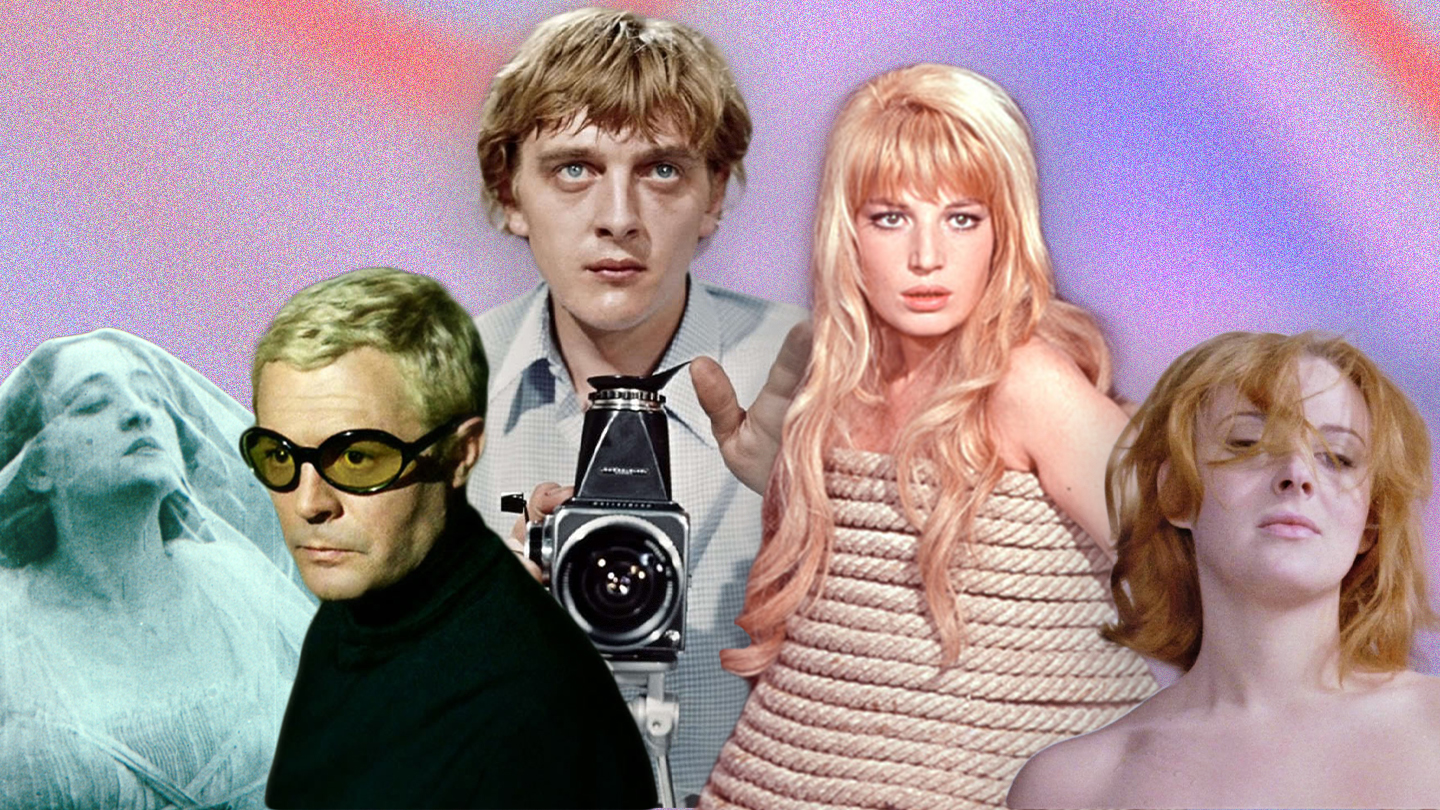This story originally appeared on i-D Italy.
Nothing is truly original and in a world oversaturated with imagery, in the creative industries and beyond, the same old cinematic references are being used and reused, chewed up and spat out with new meaning. So whether seeking inspiration for your next project or makeup look, instead of fishing from your FYP, why not elevate those sources and turn your attention to vintage Italian cinema instead.
We’ve uncovered eight old Italian films, predominantly from the 60s and 70s, to help you mix up your next moodboard.
The 10th victim (Elio Petri, 1965)
Based on a science fiction novel by Robert Sheckley, Elio Petri’s cult film is basically The Purge set in a futurist world that nods to Andy Warhol‘s pop art and the psychedelic op art of the time. The set, by Piero Poletto – an artist recognised for his avant-garde gaze – transforms the terraces of Rome’s business district into a dystopian landscape where blinding white walls meet blue skies; where costumes – from Ursula Andress’ iconic fuchsia look to Marcello Mastroianni’s bleached hair – make each frame a surreal visual essay.
Blow-Up (Michelangelo Antonioni, 1966)
Michelangelo Antonioni‘s masterpiece — often analysed for the questions it raises about the the nature of art and photography — is a jewel of visual art. The film (about “love without meaning… murder without guilt… the dazzle and madness of London today”) was produced during a pivotal moment of transition to colour films, with Antonioni deciding to limit the use of artificial light in order to accentuate the realism. From the dresses worn by Jane Birkin and Vanessa Redgrave, to the lush green lawns and the interior design of protagonist Thomas’ studio, the colours in this movie are everything.
Red Hot Shot (Piero Zuffi, 1970)
The psychedelic thriller Red Hot Shot aka Colpo Rovente (available to watch in its entirety here) was directed by Piero Zuffi, a well-known set and costume designer in Italian cinema. Think 1960s American noir but with a more refined aesthetic boasting a series of stunning scenes — like the one in which actress Barbara Bouchet wanders around a blue room wearing a dress in exactly the same colour, or the pharmaceutical lab location filled with pastel-coloured vials.
The Laughing Woman (Piero Schivazappa, 1969)
Dealing with themes of violence and trauma, The Laughing Woman (Femina ridens) encapsulates the experimental and erotic nature of Italian cinema at the end of the 1960s. The plot follows a sadistic doctor who kidnaps his secretary Mary who, far from defenceless, has actually devised an elaborate plan to kill him and end his perverse actions once and for all. From the set design to the costumes, the entire film plays on the contrast between the brutality of the protagonist and the icy and hyper-curated aesthetic of the rooms, furnished with pieces of contemporary art and giving off big gallery energy.
The Chastity Belt (Pasquale Festa Campanile, 1967)
Set during the Crusades era, The Chastity Belt is a slapstick comedy dominated by the appearance of movie star Monica Vitti, who plays a medieval woman with suspiciously 60s hair accessorised with gold armour, pastel-coloured clothing and a dog with a matching haircut. Hilarious scenes are paired with top notch styling throughout, with set design by Piero Poletto of The 10th Victim.
Blood and Black Lace (Mario Bava, 1964)
One of the most admired Italian filmmakers in the world, Mario Bava’s Blood and Black Lace (originally titled Sei Donne per l’Assassino) paved the way for all manner of Italian thrillers. “A fashion house of glamorous models becomes a terror house of blood,” reads the poster, which also promises “the 8 greatest shocks ever filmed”. With studio mannequins recalling the metaphysical paintings of Giorgio De Chirico, the use of lights instead look to pop art which, at the time, was having a real moment at the Venice Biennale. Bava’s film sets the tone for later neon-heavy fashion thrillers like Nicolas Winding Refn’s Neon Demon.
Salomè (Carmelo Bene, 1972)
Salomè is a visual feast of chromatic light effects. The scene in which 60s German supermodel Veruschka’s face is adorned with precious stones is truly iconic. Keep an eye out for the floral frames and the bodies illuminated by psychedelic lights — the latter reminiscent of Kenneth Anger’s experimental cult masterpiece Lucifer Rising, shot at the same time but released several years later.
Satanic rhapsody (Nino Oxilia, 1917)
Nino Oxilia was a poet and director who died fighting in the First World War. Three years before his death he directed Satanic Rhapsody, a dark adaptation of a tale with Faustian echoes. The story follows that of an elderly lady from high society, played by silent cinema icon Lyda Borrelli, who decides to make a pact with the devil in order to regain her lost youth and beauty. The Art Nouveau setting, the beautiful costumes and the bold, hand-painted colours make Satanic Rhapsody a real jewel of Italian silent cinema.
